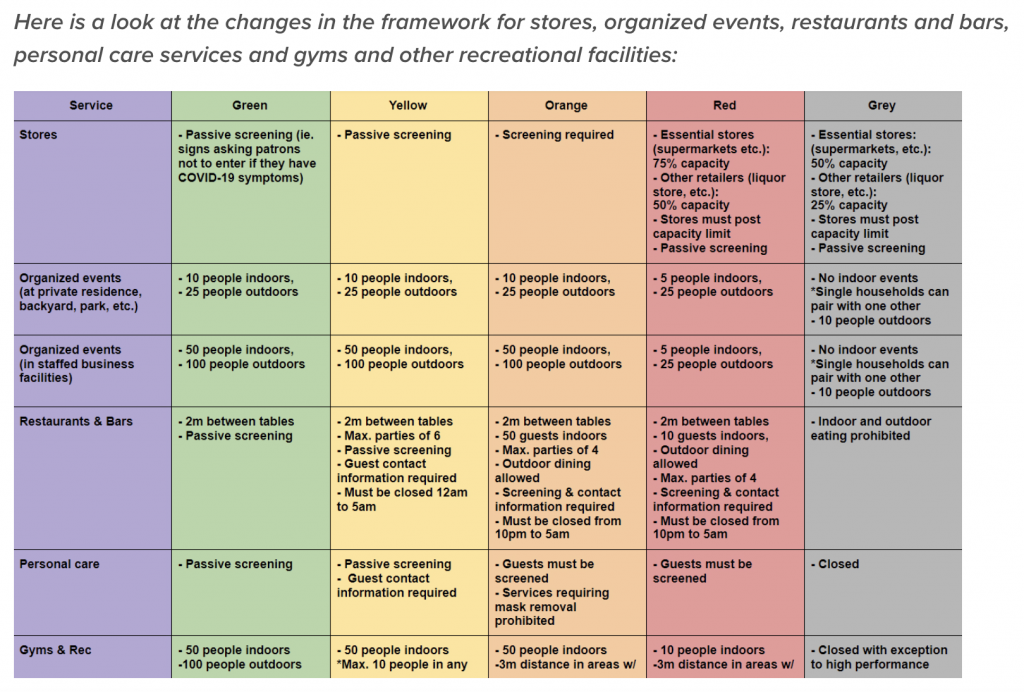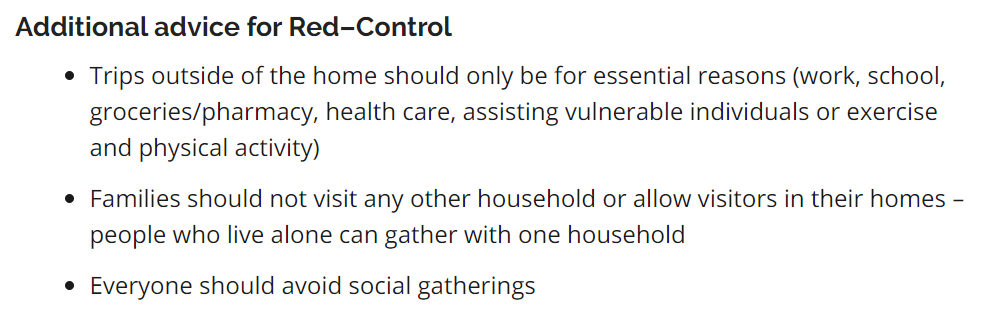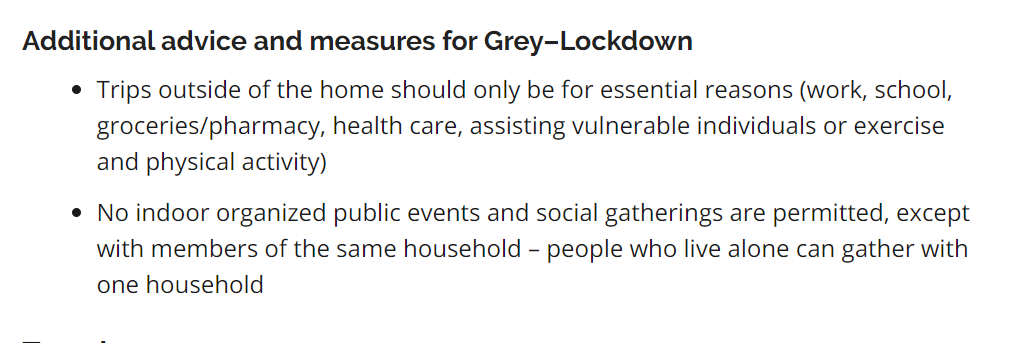Halton, Durham, and Hamilton among several regions moving to province’s “Red Zone” on Tuesday

Posted February 12, 2021 2:32 pm.
Last Updated February 12, 2021 5:33 pm.
Pandemic restrictions and a stay-at-home order will relax in 27 Ontario health units next week as the province moves forward with a reopening plan criticized in light of projections showing a likely third wave of COVID-19 in the near future without strict protections in place.
A total of 11 Ontario health units will be placed under the tightest restrictions short of a full lockdown when they return to the province’s colour-coded pandemic response framework next week.
In consultation with Chief Medical Officer of Health Dr. David Williams, the provincial government announced Toronto, Peel and York Regions, and North Bay Parry Sound District will remain in the shutdown, under the stay-at-home order, and all existing public health and workplace safety measures will continue to apply to these four regions until at least Feb. 22.
North Bay was added to the list amid an outbreak at an apartment building where at least 18 people likely have a COVID-19 variant.
As of 12:01 a.m. on Tuesday, Feb. 16, the following public health regions will move to various colour-tiers – including Halton, Durham, Hamilton, and Windsor-Essex – who will be placed under “Red-Control” and will no longer be subjected to a stay-at-home order.
Grey-Lockdown:
- Niagara Region Public Health
Red-Control:
- Chatham-Kent Public Health;
- City of Hamilton Public Health Services;
- Durham Region Health Department;
- Halton Region Public Health;
- Middlesex-London Health Unit;
- Region of Waterloo Public Health and Emergency Services;
- Simcoe-Muskoka District Health Unit;
- Southwestern Public Health;
- Thunder Bay District Health Unit;
- Wellington-Dufferin Guelph Public Health; and
- Windsor-Essex County Health Unit.
Orange-Restrict:
- Brant County Health Unit;
- Eastern Ontario Health Unit;
- Haldimand-Norfolk Health Unit;
- Haliburton, Kawartha, Pine Ridge District Health Unit;
- Huron Perth Public Health;
- Lambton Public Health;
- Ottawa Public Health;
- Porcupine Health Unit; and
- Public Health Sudbury and Districts.
Yellow-Protect:
- Algoma Public Health;
- Grey Bruce Health Unit;
- Northwestern Health Unit; and
- Peterborough Public Health.
Green-Prevent:
- Leeds, Grenville and Lanark District Health Unit; and
- Timiskaming Health Unit.
Under “Red-Control“, in-person shopping and retail are allowed for services with capacity limits, including a 75 percent capacity limit for essential stores and a 50 percent capacity for all other retail stores.
In “Grey-Lockdown“, essential stores, such as supermarkets, will operate with a 50 percent capacity limit, while all other stores would have a 25 percent capacity limit.
Under the lockdown tier, only 10 people are allowed to gather outdoors
The province began a gradual reopening of its economy Wednesday by lifting the stay-at-home order for three regions with low daily case counts and community transmission.

“The health and safety of Ontarians remain our number one priority. While we are cautiously and gradually transitioning some regions out of the shutdown, with the risk of new variants this is not a reopening or a return to normal,” said health minister Christine Elliott.
“Until vaccines are widely available, It remains critical that all individuals and families continue to adhere to public health measures and stay home as much as possible to protect themselves, their loved ones, and their communities.”
Hastings Prince Edward, Kingston, Frontenac, and Lennox & Addington, and Renfrew County and District all entered the province’s “Green-Prevent” zone this week.
Under “Green-Prevent”, the specified health unit must have a weekly percentage rate of fewer than 10 positive cases per 100,000 people.
The test positivity rate also must be under 0.5 percent, health officials say.
After returning to the colour-tiered framework, the government says health regions will stay at their level for at least two weeks at which time, “the government will assess the impact of public health and workplace safety measures to determine if the region should stay where they are or be moved to a different level.”


As such, the category each region is placed ultimately depends on their local case rates and any sudden increase in infections could lead to a change in direction. The province has also said it will use an “emergency brake” measure to move regions back into lockdown quickly if necessary.
Doctors in Toronto and Peel have warned that rolling back other restrictions as students resume in-person learning amid the spread of new virus variants could kick off a worse wave of infections.
The provincial and federal governments have been urging residents to limit their travel.
The province released another round of COVID-19 modelling and projections on Thursday highlighting its strong focus on the B.1.1.7 variant first discovered in the U.K, with health experts saying the strain could “soon dominate” the province.
The data showed that with no restrictions in place, in a best-case scenario, Ontario could see roughly 2,000 cases a day by the end of March. In a worst-case scenario, Ontario could see around 6,000 new cases per day.
Dr. Adalstein Brown noted the B.1.1.7 variant is at least 30 percent higher in terms of transmissibility than the current, original strain.
“There’s some evidence that it may also be more lethal,” said Brown. “If the B.1.1.7 variant behaves as it did in the United Kingdom, cases will start to grow here again in late February or early March; that is unless we can limit the spread through public health measures.”
The tiered system is what the Ford government and the province was practicing prior to Ontario’s lockdown on Dec. 26.
“While the trends in public health indicators are heading in the right direction, we still have work to do,” said Dr. Williams.
“Everyone is strongly advised to continue staying at home, avoid social gatherings, only travel between regions for essential purposes, and limit close contacts to your household or those you live with.”
With files from Holly Mckenzie Sutter of The Canadian Press










